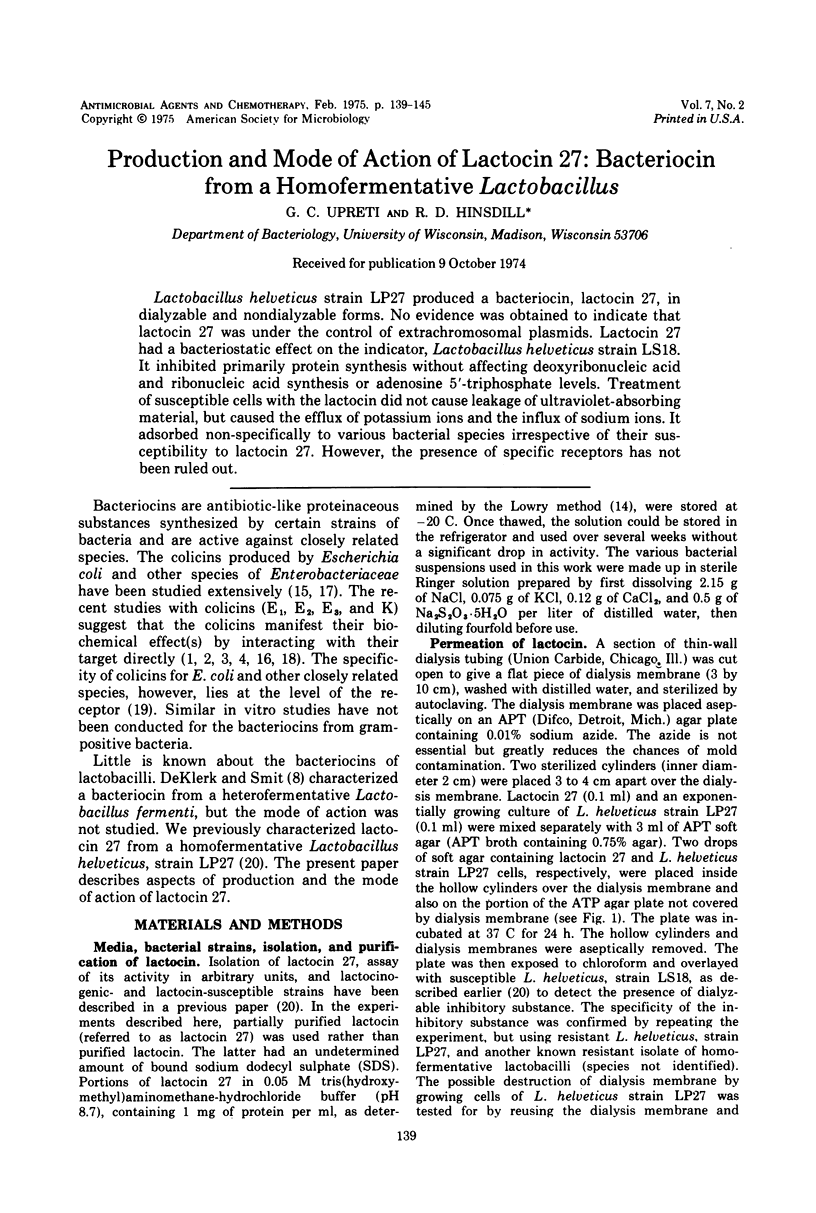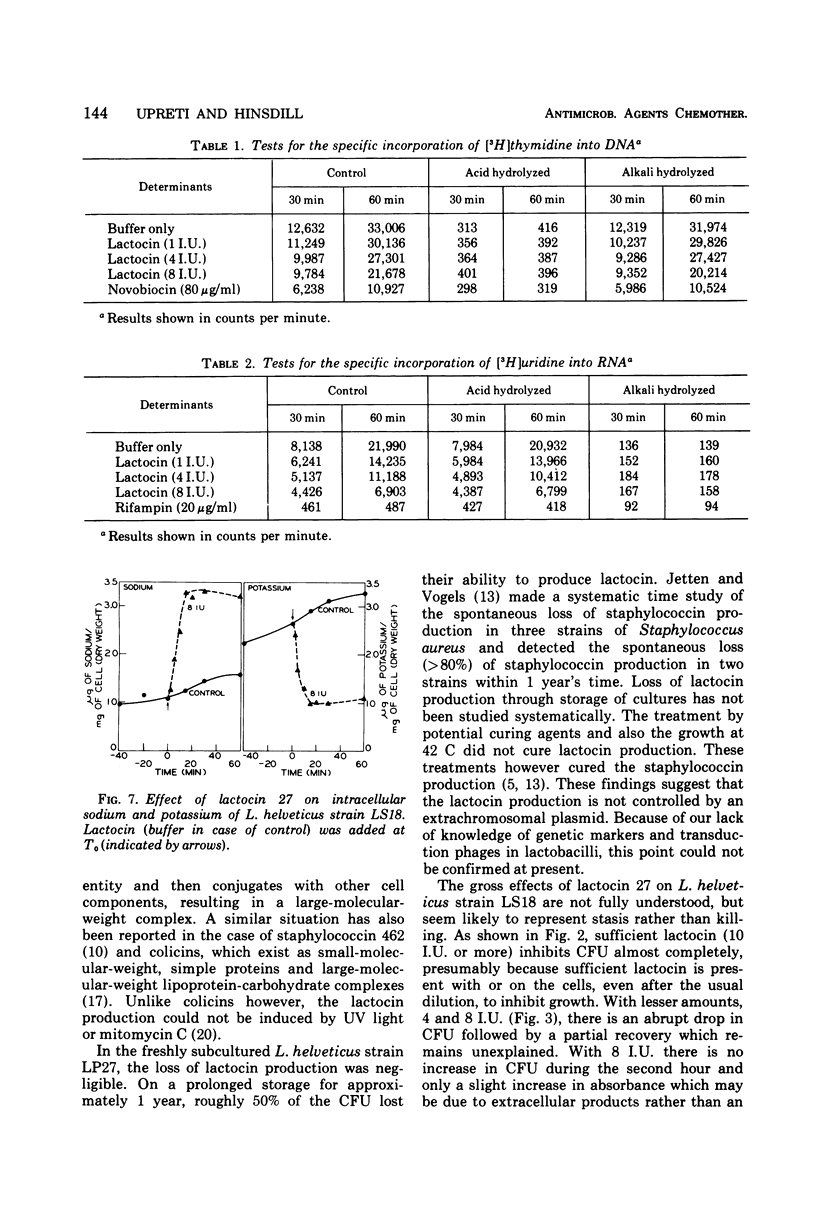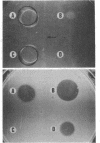Abstract
Lactobacillus helveticus strain LP27 produced a bacteriocin, lactocin 27, in dialyzable and nondialyzable forms. No evidence was obtained to indicate that lactocin 27 was under the control of extrachromosomal plasmids. Lactocin 27 had a bacteriostatic effect on the indicator, Lactobacillus helveticus strain LS18. It inhibited primarily protein synthesis without affecting deoxyribonucleic acid and ribonucleic acid synthesis or adenosine 5′-triphosphate levels. Treatment of susceptible cells with the lactocin did not cause leakage of ultraviolet-absorbing material, but caused the efflux of potassium ions and the influx of sodium ions. It adsorbed non-specifically to various bacterial species irrespective of their susceptibility to lactocin 27. However, the presence of specific receptors has not been ruled out.
Full text
PDF






Images in this article
Selected References
These references are in PubMed. This may not be the complete list of references from this article.
- Boon T. Inactivation of ribosomes in vitro by colicin E 3 . Proc Natl Acad Sci U S A. 1971 Oct;68(10):2421–2425. doi: 10.1073/pnas.68.10.2421. [DOI] [PMC free article] [PubMed] [Google Scholar]
- Boon T. Inactivation of ribosomes in vitro by colicin E 3 and its mechanism of action. Proc Natl Acad Sci U S A. 1972 Mar;69(3):549–552. doi: 10.1073/pnas.69.3.549. [DOI] [PMC free article] [PubMed] [Google Scholar]
- Bowman C. M., Sidikaro J., Nomura M. Specific inactivation of ribosomes by colicin E3 in vitro and mechanism of immunity in colicinogenic cells. Nat New Biol. 1971 Dec 1;234(48):133–137. doi: 10.1038/newbio234133a0. [DOI] [PubMed] [Google Scholar]
- Cramer W. A., Phillips S. K., Keenan T. W. On the role of membrane phase in the transmission mechanism of colicin E1. Biochemistry. 1973 Mar 13;12(6):1177–1181. doi: 10.1021/bi00730a025. [DOI] [PubMed] [Google Scholar]
- Dajani A. S., Taube Z. Plasmid-mediated production of staphylococcin in bacteriophage type 71 Staphylococcus aureus. Antimicrob Agents Chemother. 1974 Jun;5(6):594–598. doi: 10.1128/aac.5.6.594. [DOI] [PMC free article] [PubMed] [Google Scholar]
- Dajani A. S., Wannamaker L. W. Kinetic studies on the interaction of bacteriophage type 71 staphylococcal bacteriocin with susceptible bacteria. J Bacteriol. 1973 May;114(2):738–742. doi: 10.1128/jb.114.2.738-742.1973. [DOI] [PMC free article] [PubMed] [Google Scholar]
- Gagliano V. J., Hinsdill R. D. Characterization of a Staphylococcus aureus bacteriocin. J Bacteriol. 1970 Oct;104(1):117–125. doi: 10.1128/jb.104.1.117-125.1970. [DOI] [PMC free article] [PubMed] [Google Scholar]
- Hale E. M., Hinsdill R. D. Characterization of a bacteriocin from Staphylococcus aureus strain 462. Antimicrob Agents Chemother. 1973 Dec;4(6):634–640. doi: 10.1128/aac.4.6.634. [DOI] [PMC free article] [PubMed] [Google Scholar]
- Ivanovics G. BACTERIOCINS AND BACTERIOCIN-LIKE SUBSTANCES. Bacteriol Rev. 1962 Jun;26(2 Pt 1):108–118. [PMC free article] [PubMed] [Google Scholar]
- Jetten A. M., Vogels G. D. Characterization and extrachromosomal control of bacteriocin production in Staphylococcus aureus. Antimicrob Agents Chemother. 1973 Jul;4(1):49–57. doi: 10.1128/aac.4.1.49. [DOI] [PMC free article] [PubMed] [Google Scholar]
- Jetten A. M., Vogels G. D. Mode of action of a Staphylococcus epidermidis bacteriocin. Antimicrob Agents Chemother. 1972 Dec;2(6):456–463. doi: 10.1128/aac.2.6.456. [DOI] [PMC free article] [PubMed] [Google Scholar]
- LOWRY O. H., ROSEBROUGH N. J., FARR A. L., RANDALL R. J. Protein measurement with the Folin phenol reagent. J Biol Chem. 1951 Nov;193(1):265–275. [PubMed] [Google Scholar]
- Nomura M. Colicins and related bacteriocins. Annu Rev Microbiol. 1967;21:257–284. doi: 10.1146/annurev.mi.21.100167.001353. [DOI] [PubMed] [Google Scholar]
- Plate C. A. Effects of temperature and of fatty acid substitutions on colicin K action. Antimicrob Agents Chemother. 1973 Jul;4(1):16–24. doi: 10.1128/aac.4.1.16. [DOI] [PMC free article] [PubMed] [Google Scholar]
- Ringrose P. S. Interaction between colicin E2 and DNA in vitro. FEBS Lett. 1972 Jun 15;23(2):241–243. doi: 10.1016/0014-5793(72)80351-x. [DOI] [PubMed] [Google Scholar]
- Sidikaro J., Nomura M. Colicin E3-induced in vitro inactivation of ribosomes from colicin-insensitive bacterial species. FEBS Lett. 1973 Jan 1;29(1):15–19. doi: 10.1016/0014-5793(73)80005-5. [DOI] [PubMed] [Google Scholar]
- Upreti G. C., Hinsdill R. D. Isolation and characterization of a bacteriocin from a homofermentative Lactobacillus. Antimicrob Agents Chemother. 1973 Oct;4(4):487–494. doi: 10.1128/aac.4.4.487. [DOI] [PMC free article] [PubMed] [Google Scholar]
- de Graaf F. K. Effects of cloacin DF13 on the functioning of the cytoplasmic membrane. Antonie Van Leeuwenhoek. 1973;39(1):109–119. doi: 10.1007/BF02578846. [DOI] [PubMed] [Google Scholar]
- de Klerk H. C., Smit J. A. Properties of a Lactobacillus fermenti bacteriocin. J Gen Microbiol. 1967 Aug;48(2):309–316. doi: 10.1099/00221287-48-2-309. [DOI] [PubMed] [Google Scholar]



